Crafting a Winning Teaching Job Cover Letter
A well-crafted cover letter is your first opportunity to make a positive impression and secure a teaching job. It’s your chance to go beyond the resume and demonstrate your passion for education, showcase your relevant skills, and highlight how you can contribute to the school community. This guide provides comprehensive advice and examples to help you create a compelling cover letter that stands out from the competition and significantly increases your chances of landing your dream teaching position. The cover letter is an essential tool in your job application, and mastering its creation is an important step in your job search journey. It should be viewed as a marketing document where you sell yourself.
Understanding the Purpose of a Cover Letter
The primary purpose of a cover letter is to introduce yourself to the hiring manager and express your interest in a specific teaching position. It should complement your resume by providing additional context, elaborating on your qualifications, and demonstrating your personality and enthusiasm for the role. Unlike your resume, which provides a factual overview of your experience, your cover letter allows you to tell your story, explaining why you are the best candidate for the job and why you are passionate about teaching. Moreover, a cover letter is an opportunity to show your understanding of the school’s values and the specific needs of the position, which can make you stand out.
Highlighting Your Qualifications
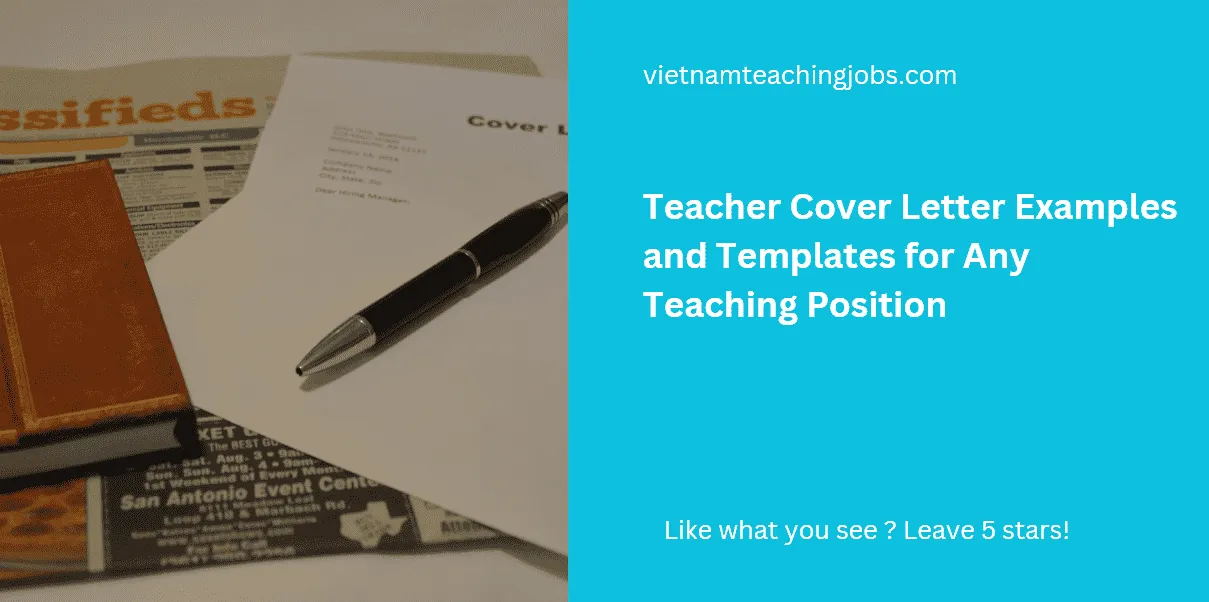
Your cover letter is the perfect space to highlight the qualifications that make you a strong candidate. These qualifications include your educational background, any certifications you hold, and any specific skills or expertise you possess that align with the job description. For example, if the job description emphasizes classroom management skills, be sure to describe your strategies for creating a positive and productive learning environment. If the position requires knowledge of specific educational technologies, highlight your proficiency. The goal is to connect your qualifications to the needs of the school and position, showing the hiring manager that you are well-suited for the role.
Showcasing Your Teaching Experience
Use your cover letter to provide examples of your teaching experience. Describe your past roles, the grades and subjects you taught, and the results you achieved. Focus on providing concrete examples of how you’ve made a positive impact on students’ learning. Use the STAR method (Situation, Task, Action, Result) to structure your examples, providing details of the challenges you faced, the actions you took, and the positive outcomes. This demonstrates your skills and abilities, making your experience more vivid and compelling. Quantify your accomplishments whenever possible such as, “Increased student test scores by 15%” or “Implemented a new reading program, which resulted in improved comprehension.”
Formatting Your Cover Letter for Impact
The visual presentation of your cover letter can significantly impact its effectiveness. Use a professional and easy-to-read font like Times New Roman, Arial, or Calibri, and maintain a consistent font size, typically between 11 and 12 points. Use standard margins (1 inch) on all sides. The letter should be single-spaced, with a space between each paragraph to improve readability. Avoid large blocks of text. The cover letter should be concise, ideally no more than one page, and formatted in a way that is easy to scan. Using bullet points can help highlight key achievements and qualifications, but use them sparingly. A well-formatted cover letter shows you pay attention to detail and respect the reader’s time.
Essential Components of a Cover Letter

Header Contact Information
Your cover letter should begin with a header that includes your contact information. This typically includes your full name, phone number, email address, and optionally, your LinkedIn profile URL or professional website. The contact information should be placed at the top of the letter, either left-aligned or centered. Make sure the information is accurate and up-to-date so the hiring manager can easily reach you. Double-check all contact details to avoid errors, and use a professional-sounding email address. Using a professional presentation increases your chances of getting an interview.
Greeting the Hiring Manager
Always address your cover letter to a specific person whenever possible. Research the name of the hiring manager or principal of the school and address the letter directly to them. Use the correct title (e.g., Mr., Ms., Dr.) and spelling of their name. A personalized greeting shows that you have taken the time to research the position and the school, demonstrating your genuine interest in the role. If you cannot find the hiring manager’s name, use a general greeting like “Dear Hiring Committee” or “Dear [School Name] Principal.” Avoid generic greetings like “To Whom It May Concern,” which can make your letter seem impersonal.
Opening Paragraph Grab Attention
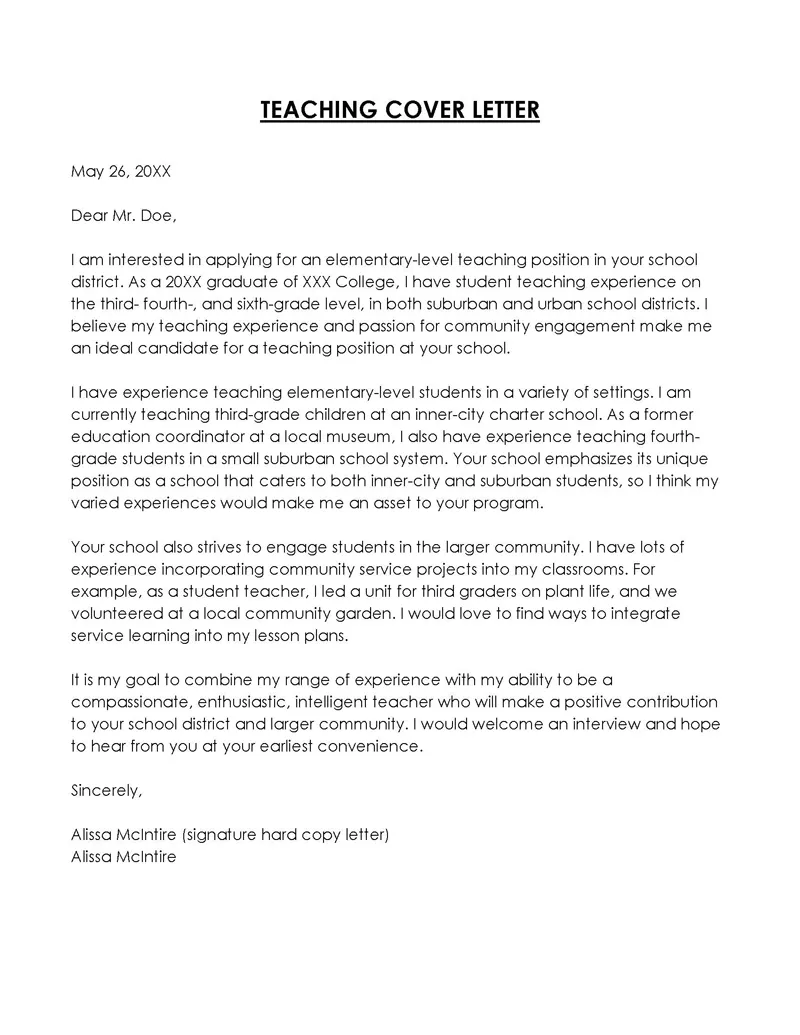
The opening paragraph of your cover letter should immediately grab the reader’s attention and clearly state the purpose of your letter. Mention the specific teaching position you are applying for and how you learned about the opportunity. Briefly state your interest in the position and the school. You can also include a brief statement about your passion for teaching or an impactful accomplishment to make a strong first impression. A well-crafted opening paragraph sets the tone for the rest of your letter and encourages the hiring manager to continue reading.
Body Paragraphs Highlight Skills
The body paragraphs are the core of your cover letter where you showcase your skills, experience, and qualifications. Focus on providing specific examples that demonstrate your abilities, and align your skills and experiences with the job requirements. Use action verbs to describe your accomplishments and quantify your achievements whenever possible. This demonstrates the impact you’ve made in previous roles. Tailor your body paragraphs to match the specific needs of the school and the requirements outlined in the job description. Mention any relevant certifications, skills, or experiences that make you stand out. Keep each paragraph concise and focused on a single point to maintain clarity.
Closing Paragraph and Call to Action
The closing paragraph should reiterate your interest in the position, thank the hiring manager for their time and consideration, and include a clear call to action. Reiterate your excitement about the opportunity and express your eagerness to discuss your qualifications further in an interview. Provide your contact information again, including your phone number and email address, and state your availability. End the letter with a professional closing like “Sincerely,” or “Best regards,” followed by your name. The call to action encourages the hiring manager to take the next step in the hiring process.
Tailoring Your Letter to the Job
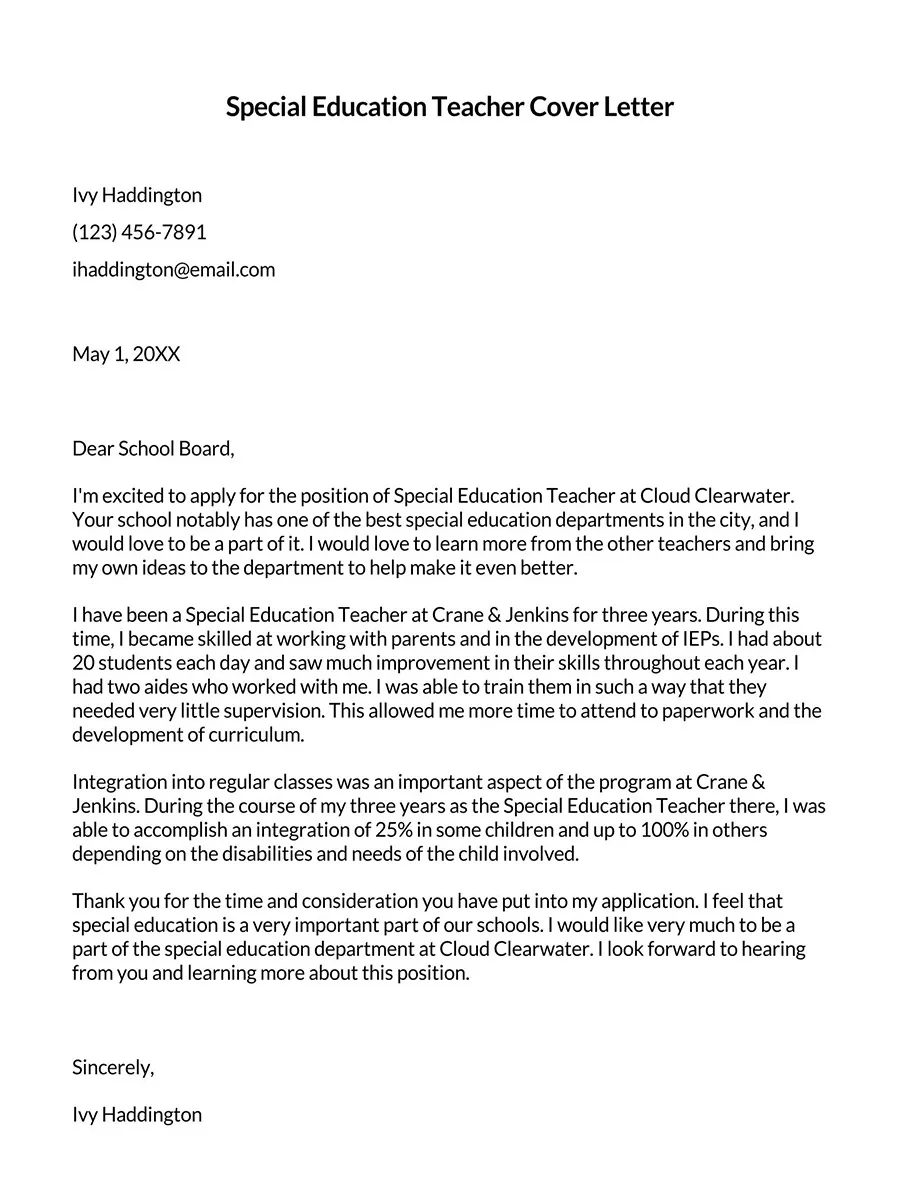
Researching the School and Position
Before writing your cover letter, thoroughly research the school and the specific teaching position. Visit the school’s website to learn about its mission, values, and educational philosophy. Understand the school’s culture and its unique needs. Review the job description carefully, paying close attention to the required skills, experience, and qualifications. This research will help you tailor your cover letter to address the specific needs of the school and demonstrate your understanding of the role. When you are tailoring your cover letter, use keywords from the job description. This shows the hiring manager that you have the right skills for the job.
Matching Your Skills to the Job Requirements
The best way to make your cover letter effective is to match your skills and experience with the requirements outlined in the job description. Review the job description carefully and identify the key skills, qualifications, and experiences the school is looking for. Then, highlight the specific examples from your past experience that demonstrate how you meet those requirements. Use similar language and keywords from the job description to show how your skills and experiences align with the needs of the school. This targeted approach helps to convince the hiring manager that you are a strong fit for the position.
Using Keywords Effectively
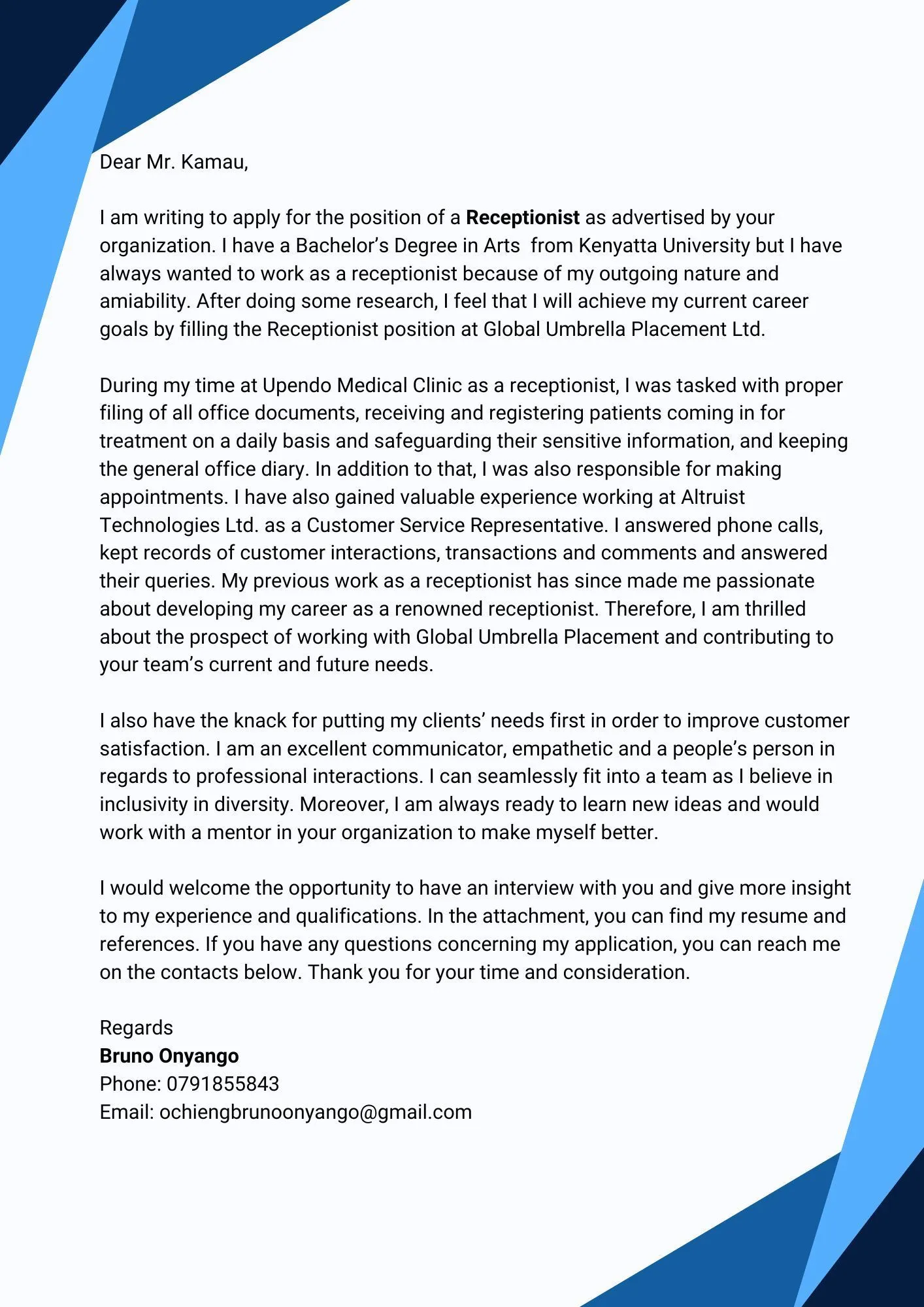
Keywords are essential for your cover letter. Carefully review the job description and identify the keywords and phrases that the school uses to describe the desired qualifications, skills, and experiences. Integrate those keywords naturally throughout your cover letter. Use them in your opening paragraph, body paragraphs, and closing paragraph. However, avoid keyword stuffing, which can make your letter sound unnatural and detract from its effectiveness. The goal is to highlight your skills and experience with the appropriate keywords, demonstrating that you have the qualifications needed for the teaching position.
Reviewing and Editing Your Cover Letter
Proofreading for Grammar and Spelling
Before submitting your cover letter, meticulously proofread it for any grammatical errors, spelling mistakes, or typos. These errors can damage your credibility and create a negative impression with the hiring manager. Use a grammar checker and spell checker, but also carefully read the letter yourself, word-for-word. Pay attention to punctuation, capitalization, and sentence structure. It is essential that your cover letter is polished and professional. A few errors can make the difference between getting hired and getting passed over.
Seeking Feedback from Others
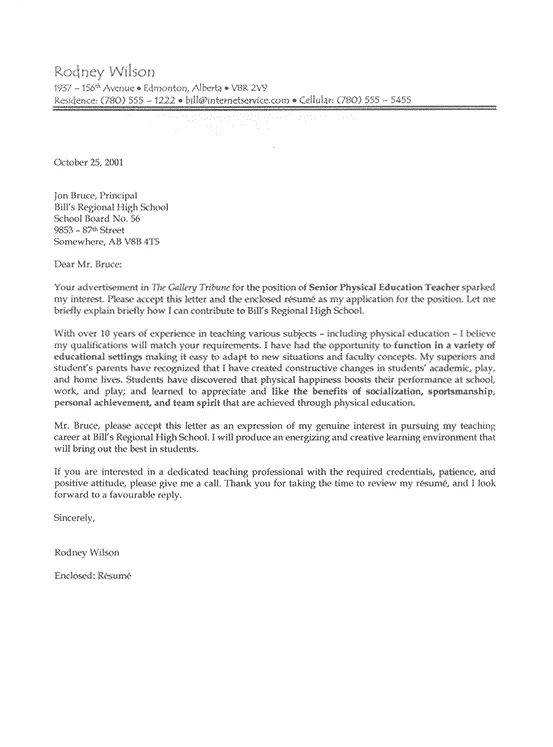
Ask friends, family, or career advisors to review your cover letter. Seek feedback on the clarity, structure, and content of your letter. Ask them if the cover letter effectively highlights your skills and experiences and if it reflects your personality and passion for teaching. Get feedback from multiple sources to gain different perspectives. Consider asking current or former teachers or mentors for feedback. Their insight and suggestions can help you improve your cover letter significantly. Make the necessary revisions based on the feedback and ensure your cover letter is the best it can be.
Using a Template
Using a template can be a great way to create a well-structured cover letter, especially if you’re starting from scratch. Many online resources offer free cover letter templates specifically designed for teaching positions. However, do not rely solely on a template. Tailor the template to match your specific skills and experiences, and the requirements of the job description. Customize the language, examples, and content to make sure it is unique and reflective of your own qualifications. Make sure that you don’t use the same cover letter for multiple job applications. Make sure that it highlights the school you are applying to.
Examples of Effective Cover Letters
Early Career Teacher Examples
An early career teacher’s cover letter should focus on enthusiasm, educational background, and relevant skills. It should highlight any student teaching experience, volunteer work, and any extracurricular activities that involved working with children. The letter should also emphasize the candidate’s eagerness to learn and grow as an educator and their willingness to collaborate with colleagues. Examples of successful cover letters for early career teachers usually highlight their coursework, certifications, and specific teaching methods and technologies. Show that you are ready and enthusiastic to take on the challenge.
Experienced Teacher Examples
Experienced teachers should focus on demonstrating a track record of success, including their accomplishments and any leadership roles they have held. The letter should include specific examples of how they’ve improved student outcomes, implemented innovative teaching strategies, or mentored other teachers. A strong cover letter for an experienced teacher will highlight their achievements, such as awards, publications, or recognition. They will also discuss experience with curriculum development, assessment, and school initiatives. Focus on the impact you made in your past positions.
Special Education Teacher Examples
A cover letter for a special education teacher should emphasize experience working with students with disabilities, along with specific skills in areas such as IEP development, behavior management, and differentiated instruction. The letter should highlight knowledge of various disabilities and the ability to create a supportive and inclusive classroom environment. The letter should emphasize your commitment to supporting the social and emotional well-being of special education students. If you have special certifications or experience in specific programs, make sure to mention it. Also, discuss your experience working with parents and other support staff.
Cover Letter Mistakes to Avoid
Generic Letters
One of the biggest mistakes is sending a generic cover letter that could be used for any job. A cover letter should be tailored to the specific position and the school. Make sure that you have researched the school and the role. Generic letters don’t stand out and can be quickly dismissed by hiring managers. Make sure that you personalize the letter to the specific job and highlight how your skills and experiences align with the requirements and needs of the school. Personalization includes addressing the hiring manager by name, and demonstrating knowledge of the school’s mission, vision, and values.
Typos and Grammatical Errors
Typos and grammatical errors are a huge turnoff. These errors reflect a lack of attention to detail and professionalism. Always proofread your cover letter carefully before submitting it. Use a grammar checker and spell checker, but also read the letter yourself, word-for-word. Ask someone else to review it. Even a few errors can make the difference between getting hired and getting passed over. A polished cover letter demonstrates your commitment to excellence.
Focusing on Yourself
While it’s important to showcase your qualifications, avoid making your cover letter overly self-centered. Focus on the school’s needs and how you can contribute to the students and school community. Instead of simply listing your accomplishments, explain how those accomplishments translate into benefits for the students and the school. Demonstrate your understanding of the school’s values and the specific needs of the position. Show that you’ve researched the school and are genuinely interested in the opportunity. Making it about the school rather than yourself can greatly increase your chances of securing the job.
